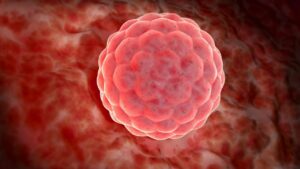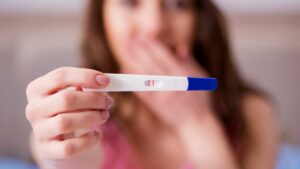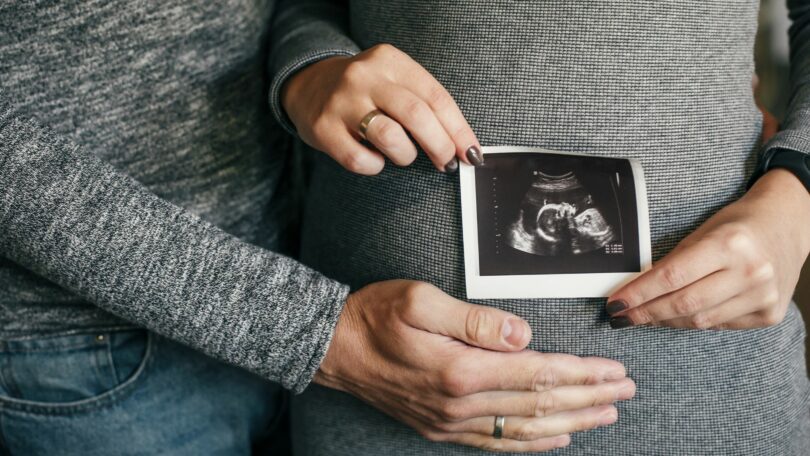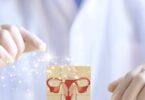Implantation (or nidation) is the actual starting signal for pregnancy. It requires a complex interaction between the embryo and the uterine lining (endometrium). In this article we explain what happens during implantation and how you can support it.
What happens during implantation?
After ovulation, the egg is fertilized in the fallopian tube by male sperm cells and a zygote (fertilized egg) is formed. Within four to five days, this zygote migrates through the fallopian tube into the uterine cavity. During this time, the fertilized egg cell divides several times and develops into the so-called blastocyst, which consists of an outer and inner cell group. The embryo develops from the inner cell group of the blastocyst.
| Info box:
The blastocyst, consisting of an outer cell layer and an inner cell mass, forms the placenta and embryo, respectively. |
As soon as the fertilized egg reaches the uterus, a complex exchange occurs between the embryo and the uterine lining with the help of various signaling molecules. Scientists speak of a “dialogue between embryo and mother”. In most cases, however, the future mother does not notice much of this.
|
Info box: The uterine lining consists of two layers: a permanent lower layer and a newly regenerated upper layer that is shed during menstruation (cycle without fertilization). Under the influence of hormones such as progesterone and estradiol, the nourishing layer of the uterine lining develops after ovulation and thus enables implantation. For successful implantation, the uterine lining should ideally reach a thickness of 7–10 mm. |
Think of this dialogue as a negotiation in which the uterine lining agrees to remove a protective layer so that the blastocyst can implant. This layer normally prevents pathogens from entering.
During implantation, the outer layer of the blastocyst attaches to the uterine lining and forms a network of finger-like projections called villi. These villi are connected to the mother’s blood vessels and thus ensure the supply of nutrients and oxygen to the embryo. Once this process is complete, the implantation is successful.

The pregnancy hormone hCG (human chorionic gonadotropin) begins to increase daily and peaks at the end of the first trimester. It is this hormone that is detected by pregnancy tests. It helps pregnancy by maintaining progesterone production from the corpus luteum, thus preventing further ovulation.

Where does implantation take place?
Implantation typically occurs in the middle third of the uterus. Communication via signaling molecules is thought to guide the embryo to a favorable location.
In some cases, the egg implants in the lower part of the uterus, potentially causing some difficulties during pregnancy and childbirth, especially if there is placenta previa, in which the placenta covers the cervix.
In about one in 100 women, the egg implants outside the uterus, for example in the fallopian tube, resulting in an ectopic pregnancy, which requires medical intervention due to the risk to the woman’s health. This also applies to implantation into the abdominal cavity, which is even rarer and often results from problems such as a blocked fallopian tube or an abnormal uterus.
What can hinder nidation?
There are various reasons why a fertilized egg cannot implant and pregnancy does not occur. These include certain maternal mediacl problems such as fibroids, endometriosis or impaired sugar metabolism. But an unhealthy lifestyle can also affect the implantation process. Women who want to have children will therefore want to avoid alcohol and cigarettes. This only supports implantation but also protects the development of the embryo. It is advisable to avoid physical and mental stress and instead rest regularly, mind a healthy sleep and sufficient exercise to reduce everyday stress.
Can you support implantation?
Unfortunately, you cannot directly influence the implantation process. However, you can help your body adjust to pregnancy more quickly by exercising regularly, reducing stress, eating a balanced diet, and getting an optimal supply of vitamins and minerals.
Unfortunately, there have so far only been small scientific studies on how certain vitamins or foods promote implantation. However, it doesn’t hurt to take some vitamins to create good physical conditions for implantation. The uterine lining plays an important role in implantation, as it can only accept an egg if it has a good blood supply, has two layers and is sufficiently thick.
Certain nutrients show promising properties to support this process, such as
Whole grain products
A diet with many whole grains was associated with a higher likelihood of a live birth in women undergoing fertility treatment in one study. The study authors attributed this to improved endometrial structure with higher thickness on the day of embryo transfer and improved receptivity. This significantly increased the likelihood of implantation.
Water
Experts consider blood flow to the uterine lining to be very important for successful implantation. In order to promote it, in addition to nutrients such as the B vitamins just mentioned, it is important to drink enough. Prefer sugar-free drinks (without caffeine). Recommendations such as relaxation and regular exercise also aim to optimize blood circulation.
Vitamin E and C
These vitamins provide the uterine lining with nutrients so that the egg can implant well.
Vitamin D
From studies on women in whom implantation fails repeatedly, we now know that an adequate supply of vitamin D is also important. A healthy vitamin D level seems to facilitate the above-mentioned dialogue between embryo and mother by having a positive effect on the production of certain signaling substances.
B vitamins
B vitamins are needed for homocysteine detoxification. This is a breakdown product in the metabolism of certain protein building blocks. If there is B vitamin deficiency, homocysteine accumulates because it cannot be detoxified quickly enough. This has a negative effect on the blood vessels, so blood flow to the uterine lining is not ideal.
Zinc, iron and magnesium
A sufficient supply of these trace elements is essential for fertility and the development of the baby.
Folic acid
Most health authorities recommend that women who want to have children take at least 400 micrograms of folate daily as it is important for pregnancy. In particular, good care reduces the risk of childhood malformations.
Can a woman feel implantation?
There are very different experiences with this. Some women do not notice implantation at all, others feel a slight pulling sensation in their lower abdomen. Mild cramps or pain in the lower back area can also be signs of implantation. Minor bleeding sometimes occurs as maternal and fetal tissues join together during implantation. This is called nidation bleeding.
Credentials
Gaskins AJ, Chiu YH, Williams PL, Keller MG, Toth TL, Hauser R, Chavarro JE; EARTH Study Team. Maternal whole grain intake and outcomes of in vitro fertilization. Fertil Steril. 2016 Jun;105(6):1503-1510.e4. doi: 10.1016/j.fertnstert.2016.02.015. Epub 2016 Feb 28. PMID: 26926253; PMCID: PMC4894002.
Gonzalez-Martin R, Palomar A, Quiñonero A, Pellicer N, Fernandez-Saavedra R, Conde-Vilda E, Quejido AJ, Whitehead C, Scott RT Jr, Dominguez F. The Impact of Essential Trace Elements on Ovarian Response and Reproductive Outcomes following Single Euploid Embryo Transfer. Int J Mol Sci. 2023 Jun 30;24(13):10968. doi: 10.3390/ijms241310968. PMID: 37446146; PMCID: PMC10341631.
Kermack, A., Lowen, P., Wellstead, S., Fisk, H., Montag, M., Cheong, Y., Osmond, C., Houghton, F., Calder, P., & Macklon, N. (2019). Effect of a 6-week “Mediterranean” dietary intervention on in vitro human embryo development: the Preconception Dietary Supplements in Assisted Reproduction double-blinded randomized controlled trial.. Fertility and sterility. https://doi.org/10.1016/j.fertnstert.2019.09.041.
Kucuk T, Horozal PE, Karakulak A, Timucin E, Dattilo M. Follicular homocysteine as a marker of oocyte quality in PCOS and the role of micronutrients. J Assist Reprod Genet. 2023 Aug;40(8):1933-1941. doi: 10.1007/s10815-023-02847-3. Epub 2023 Jun 10. PMID: 37300649; PMCID: PMC10371946.
Kuroshli Z, Novin MG, Nazarian H, Abdollahifar MA, Zademodarres S, Pirani M, Jahvani FA, Fathabady FF, Mofarahe ZS. The Efficacy of Vitamin D Supplement in the Expression and Protein Levels of Endometrial Decidualization Factors in Women with Recurrent Implantation Failure. Reprod Sci. 2024 Mar;31(3):675-686. doi: 10.1007/s43032-023-01349-y. Epub 2023 Oct 10. PMID: 37816991.
Ma X, Wu L, Wang Y, Han S, El-Dalatony MM, Feng F, Tao Z, Yu L, Wang Y. Diet and human reproductive system: Insight of omics approaches. Food Sci Nutr. 2022 Mar 21;10(5):1368-1384. doi: 10.1002/fsn3.2708. PMID: 35592285; PMCID: PMC9094499.







